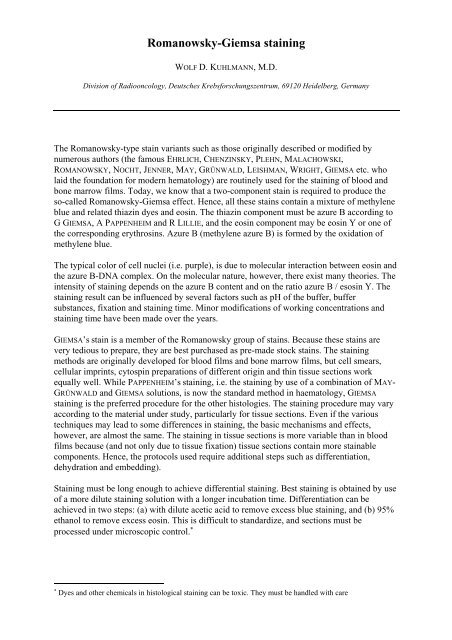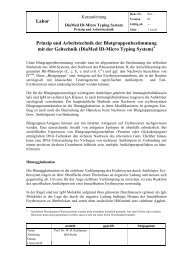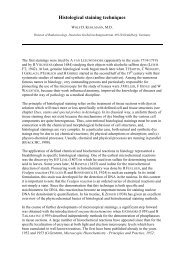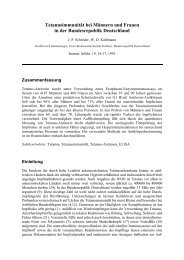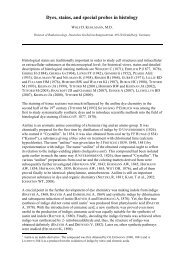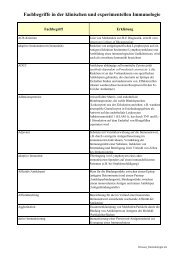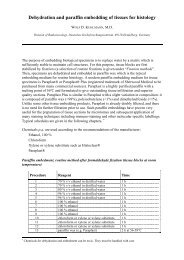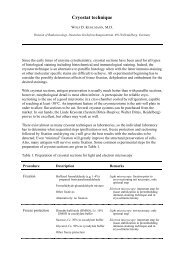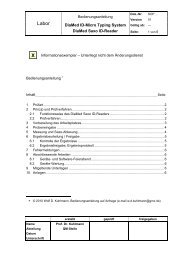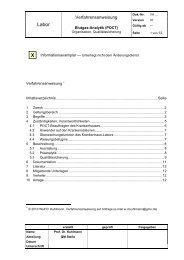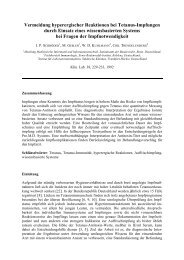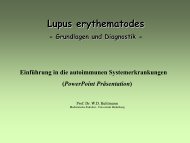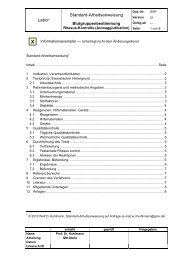You also want an ePaper? Increase the reach of your titles
YUMPU automatically turns print PDFs into web optimized ePapers that Google loves.
<strong>Romanowsky</strong>-<strong>Giemsa</strong> <strong>staining</strong>WOLF D. KUHLMANN, M.D.Division of Radiooncology, Deutsches Krebsforschungszentrum, 69120 Heidelberg, GermanyThe <strong>Romanowsky</strong>-type stain variants such as those originally described or modified bynumerous authors (the famous EHRLICH, CHENZINSKY, PLEHN, MALACHOWSKI,ROMANOWSKY, NOCHT, JENNER, MAY, GRÜNWALD, LEISHMAN, WRIGHT, GIEMSA etc. wholaid the foundation for modern hematology) are routinely used for the <strong>staining</strong> of blood andbone marrow films. Today, we know that a two-component stain is required to produce theso-called <strong>Romanowsky</strong>-<strong>Giemsa</strong> effect. Hence, all these stains contain a mixture of methyleneblue and related thiazin dyes and eosin. The thiazin component must be azure B according toG GIEMSA, A PAPPENHEIM and R LILLIE, and the eosin component may be eosin Y or one ofthe corresponding erythrosins. Azure B (methylene azure B) is formed by the oxidation ofmethylene blue.The typical color of cell nuclei (i.e. purple), is due to molecular interaction between eosin andthe azure B-DNA complex. On the molecular nature, however, there exist many theories. Theintensity of <strong>staining</strong> depends on the azure B content and on the ratio azure B / esosin Y. The<strong>staining</strong> result can be influenced by several factors such as pH of the buffer, buffersubstances, fixation and <strong>staining</strong> time. Minor modifications of working concentrations and<strong>staining</strong> time have been made over the years.GIEMSA’s stain is a member of the <strong>Romanowsky</strong> group of stains. Because these stains arevery tedious to prepare, they are best purchased as pre-made stock stains. The <strong>staining</strong>methods are originally developed for blood films and bone marrow films, but cell smears,cellular imprints, cytospin preparations of different origin and thin tissue sections workequally well. While PAPPENHEIM’s <strong>staining</strong>, i.e. the <strong>staining</strong> by use of a combination of MAY-GRÜNWALD and GIEMSA solutions, is now the standard method in haematology, GIEMSA<strong>staining</strong> is the preferred procedure for the other histologies. The <strong>staining</strong> procedure may varyaccording to the material under study, particularly for tissue sections. Even if the varioustechniques may lead to some differences in <strong>staining</strong>, the basic mechanisms and effects,however, are almost the same. The <strong>staining</strong> in tissue sections is more variable than in bloodfilms because (and not only due to tissue fixation) tissue sections contain more stainablecomponents. Hence, the protocols used require additional steps such as differentiation,dehydration and embedding).Staining must be long enough to achieve differential <strong>staining</strong>. Best <strong>staining</strong> is obtained by useof a more dilute <strong>staining</strong> solution with a longer incubation time. Differentiation can beachieved in two steps: (a) with dilute acetic acid to remove excess blue <strong>staining</strong>, and (b) 95%ethanol to remove excess eosin. This is difficult to standardize, and sections must beprocessed under microscopic control. ∗∗ Dyes and other chemicals in histological <strong>staining</strong> can be toxic. They must be handled with care
<strong>Giemsa</strong> <strong>staining</strong> (cell smears, cytospins, frozen sections)ChemicalsAzure B-Eosin stock solution (Merck),<strong>Giemsa</strong>’s azure eosin methylene blue solutioncontainingAzure B (C.I. 52010) andMethylene blue (C.I. 52015) andEosin Y (C.I. 45380)HEPES, free acidHEPES, sodium saltMethanolDistilled waterChemical solution• HEPES stock A:0.1 M HEPES (free acid) in distilled water• HEPES stock B:0.1 M HEPES (sodium salt) in distilledwater• HEPES buffer:900.0 mL HEPES stock A plus100.0 mL HEPES stock Bif necessary, adjust pH to 6.5(buffer is stable for months at 4°C)• HEPES buffer working:300.0 mL HEPES buffer plus700.0 mL distilled water(corresponds to 0.03 mol/L HEPES)• GIEMSA diluted dye solution:1.0 mL Azure B-Eosin stock solution plus25.0 mL HEPES buffer working solutionStaining procedureAir-dried specimens are fixed and stained:− methanol 3-5 min− GIEMSA diluted dye solution 5-10 min− HEPES working buffer 2 x 1 min− distilled water 1 x rinseSlides are air-dried in vertical position<strong>Giemsa</strong> <strong>staining</strong> (paraffin sections)<strong>Giemsa</strong>’s stain is principally used for blood and bone marrow films but can be also applied totissue sections; cut thin (2 µm) paraffin sections, tonsils may serve as control material.ChemicalsGIEMSA stock solution (Merck),(Azure eosin methylene blue solution)containingAzure B (C.I. 52010) andMethylene blue (C.I. 52015) andEosin Y (C.I. 45380)Sodium acetateGlacial acetic acidn-ButanolChemical solution• Acetate buffer stock solution:0.2 M acetate buffers with different pH(in the range of pH 3.5 to 7.0) are preparedand examined in preliminary experimentsbecause pH optimum for the study materialshould be determined previously)• GIEMSA diluted dye solution:1.0 mL <strong>Giemsa</strong> stock solution plus50.0 mL 0.02 M acetate buffer solution(1:10 dilution of 0.2 M acetate buffer, the
Distilled waterright pH is adjusted with 5% acetic acid)• Acetate wash buffer:10.0 mL 0.2 M acetate buffer plus90.0 mL distilled waterpH is adjusted with 5% acetic acid• 0.01% acetic acidStaining procedureSections are passed through distilled water and stained:− GIEMSA diluted dye solution 1-2 hours− acetate wash buffer 3 dips−blot dry and control with the microscope; if “blue” predominates, differentiate in acetic acid− differentiate in 0.01% acetic acid optionalunder microscopic control ∗− acetate wash buffer 2-3 dips−blot dry− n-butanol 2 x 3 minSlides are cleared in xylene or xylene substitute and mounted in resinous medium undercoverglass∗Fixation influences the color balance of <strong>Giemsa</strong> <strong>staining</strong>, and best results are obtainedwith appropriate pH of the <strong>staining</strong> solution. Adequate pH is determined by trial with<strong>Giemsa</strong> <strong>staining</strong> solutions prepared with acetate buffers in the range from pH 3.5-7.0. If“blue” predominates, then the pH is too high, and if “red” predominates, a higher pHmust be chosenReferences for further readingsEhrlich P (1879)Nocht B (1898)<strong>Romanowsky</strong> D (1891)Unna P (1891)Pappenheim A (1899)Ewing J (1900)<strong>Giemsa</strong> G (1902)Wright J (1902)<strong>Giemsa</strong> G (1903)<strong>Giemsa</strong> G (1904)Wilson TM (1907)Pappenheim A (1908)Lillie R (1944)Marshall PN et al. (1975)Lillie RD and Fullmer HM (1976)Marshall PN et al. (1978)Wittekind DH (1983)Schulte E (1987)
Wittekind D (1983)Kamino H and Tam ST (1991)Woronzoff-Dashkoff KP (1993)Kligora CJ et al. (1999)Horobin RW and Kiernan AJ (Conn’s Biological Stains, 2002)© Prof. Dr. Wolf D. Kuhlmann, Heidelberg 10.09.2006


